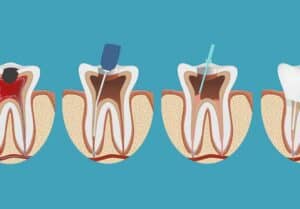
Root canal treatment is a dental treatment used to treat the infection in the center of the tooth. Root canal treatment is not a painful procedure, on the contrary, if a tooth needs to be extracted completely, in some cases, root canal treatment can completely save a tooth from this situation.
Now Aesthetic
Contact

When Is Root Canal Treatment Needed?
Root canal treatment may be required if there is a bacterial sign in your X-ray results. If the tooth enamel is infected by bacteria, it can become inflamed, causing the bacteria to multiply and spread.
Pulp Infection Symptoms;
Pain when eating or drinking something hot or cold
Pain when biting or chewing
A loose tooth
In the advanced stages of the infection, as the dental pulp progresses to a worse condition, these symptoms are no longer seen. So you may think that your tooth is getting better, but actually the situation is getting worse;
Swelling of the gums near the infected tooth
Pyorrhea from the infected tooth
Cheek or chin swelling
Tooth darkening
The dental pulp does not heal on its own. If you feel pain in your tooth, you should consult a dentist directly. In cases where the infection in your tooth progresses, root canal treatment may no longer prevent this condition. Although the drugs used for bacterial infections do not act like root canal treatment, they can stop the infection that may spread around the infected tooth, but root canal treatment is the only solution.
Treatment Steps for Root Canal Treatment
Root canal treatment is the process of removing the small thread in the center of the tooth. After the pulp, that is, the damaged structure of the pulp is removed, the empty part is cleaned well, and the filling process is performed according to the tooth format. In this procedure, the root canal of the teeth is closed. Before the root canal treatment, the sick teeth were extracted. However, with root canal treatment, it prevents the teeth from being negatively affected and receding for a long time.
The Most Important Stages of Root Canal Treatment
Root canal treatment is a matter that may require more than one session depending on the condition of the tooth. The most important stages of root canal treatment are as follows.
• Cleaning the root canal,
• Filling the root canal,
• Adding and filling crowns,
Thanks to the above-mentioned steps, your teeth reach a healthier and longer-lasting structure. The treated or repaired tooth may not cause a lifelong problem within the framework of the correct care rules.
Cleaning the Root Canal
Dentists remove everything in the root canal as the first step for dental canal treatment. During this procedure, local anesthesia is applied to the patient. The dentist begins to make a small hole in the face of the tooth. Harvest and dead pulp removal process is started from this area with the help of instruments. Dead tissues are removed with small touches by the specialist physician.
Filling the Root Canal
After the root canal is cleaned well, the dentist cleans it further with imitation solutions and shapes the area. It is filled using an adhesive cement to fill the empty spaces. This material has a tooth rubber-like quality. The root canal treatment is performed easily when the tooth is dead.
Adding and Filling Crowns
Some supplies need to be made as root canal filled teeth have a more fragile structure than before. In this direction, crown and filling protection is applied to the teeth. People need to be careful until the crown and filling process is completed. While eating, chewing should not be too much and biting should be avoided. After the crown and filling process is completed, patients can now use their old teeth. Dental canal treatment stages can be sessions depending on the condition of the tooth. In cases of multi-channel and infection, the sessions may be longer because the treatment is prolonged.
Root canal treatment fees vary between $200 and $300 in Turkey. This price can fluctuate up or down depending on the exchange rate.
Root canal treatment is the process of removing the small, thread-shaped tissue in the center of the tooth, namely the pulp.

Now Aesthetic © All rights reserved.
